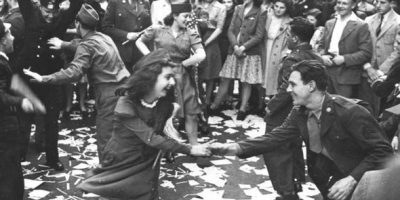Glenn Miller was an American jazz musician during WWII. As a child he moved around frequently from Iowa, to Nebraska, to Missouri where he started playing the trombone in the town band, to finally Colorado where he, again, joined another band; his high school band. Music was a prominent part of his life, he even dropped out of the University of Colorado in 1923 to join other musical groups and bands. In 1934 he started to record under his own name but his success didn’t take off until 1938. Then when WWII starts, Miller left music to go to the navy, however he told that he was not needed. In 1942 he tried again, but this time for the Air Force. He became captain in the Army Specialist Corps and managed to keep up with his love for music. He organized the Glenn Miller Army Air Force Band which had over 800 performances. Miller was also the host of ‘Sustain the Wings’ radio show, he wrote 70 top ten hits – a few being “In the Mood”, “A String of Pearls”, “Little Brown Jug” and “Moonlight Serenade”.
Glenn Miller was a name known throughout the swing era, he played the trombone, he was an arranger, composer, and band leader. His hit instrumental “In the Mood” released in 1939 became one of those defining songs of the swing era. It’s “a bouncy fox trot that got the older people on the floor and appeased a younger crowd eager for killer-dillers. There was also the famous fade away section, which never seems to lose its element of suspense upon repeated listening’s.” (Rickert, 2) It was on the Record Buying Guide, a jukebox list, for 13 weeks and was on the Billboard charts for 30 weeks. “In the Mood” was also inducted into the Grammy Hall of Fame in 1983 and is recognized as one of the most popular instrumentals. You may have heard it before if you’ve ever seen the 1998 remake of The Parent Trap starring Lindsay Lohan. https://www.youtube.com/watch?v=Gi6AGWDa5-A
“In the Mood” has also made other appearances on Scrubs, Gilmore Girls, Doctor Who, etc.
In 1994, the studio recording of “In the Mood” was released on a V-Disc, which was part of a series of recordings the U.S. War Department sent free overseas to military personnel. Then in 1945, Miller’s overseas band recorded a second version and that was released as another V-Disc in 1948. Not only did U.S. military personnel listen to the stylings of Glenn Miller but there was also another recording of “In the Mood” that was also played in Germany in 1944 on The Wehrmacht Hour, a radio program. However the Swiss had already recorded their own cover of “In the Mood” that was released April 1940 by Teddy Stauffer und seine Original Teddies in Zurich; and then a year later there was another version recorded by Ernst van’t Hoff , February 1941 in Berlin.
“In the Mood” was such a popular swinging, energetic song that it’s understandable that other people would want to take their own stab at it. Originally the arrangement was created by Joe Garland and he had a recording of his version in 1938, but his had a baritone saxophone duet instead of the tenor sax. In the next year, Garland sold the tune of “In the Mood” to Glenn Miller. Miller then tinkered around with it for a while, taking some parts out, rearranging others, and when he was done his version is the one that became the most well-known, even to this day.
Work Cited:
https://www.tunefind.com/artist/glenn-miller
In the Mood (U.S. government German-language broadcast recording). learnnc.com.
Glenn Miller German Wehrmacht Hour. RadioEchoes.com.
Heiner Bontrup, E. Dieter Fränzel: Wiederentdeckung einer Swing-Legende. Die Ernst Höllerhagen Story. Ein Jazzmusiker zwischen Nationalsozialismus und Wirtschaftswunder. Mit Diskographie 1934−1955. Nordpark, Wuppertal 2011, ISBN 978-3-935421-42-3, p. 141.
“In the Mood”, Orchester Ernst van’t Hoff, Polydor 47522, Matrix number 8925 GD-2, produced in Berlin, February 1941
Rickert, David . “Glenn Miller: In the Mood.” All About Jazz, 27 Dec. 2005, www.allaboutjazz.com/glenn-miller-in-the-mood-glenn-miller-by-david-rickert.php?
page=1. “ Glenn Miller “Sustain the Wings”.” Wartime Entertainment in WWII, 2009, www.mtholyoke.edu/~knigh20c/classweb/miller.html.
Flower, John (1972). Moonlight Serenade: a bio-discography of the Glenn Miller Civilian Band. New Rochelle, NY: Arlington House, pages 79-81. ISBN 0-87000-161-2







Melissa Dinsman
Your covering of Miller’s history as a musician and this song is well done, but you don’t address Miller’s mysterious death. Also, do you mean 1994 or 1944? I think it is the latter, correct? From your research did you find out why this song became so popular and remains so today? As you say, the song is recognizable because of its continues use on TV and in film? Why do you think this is? Does it have anything to do with Miller himself?